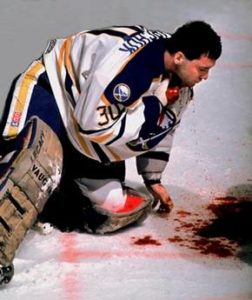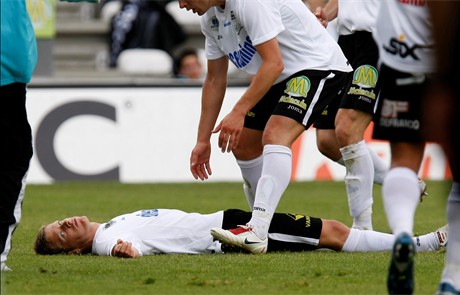#4: NFL Safety Ronnie Lott Amputates His Own Finger
In 1985, the 49ers great Ronnie Lott happened to misplace his pinkie finger after two colliding helmets exploded the living crap out of it. Most men would have ran to the sideline squealing for help, but Lott knew that having surgery to repair the finger would probably have ended his season- healing takes time. He was not the type of guy to have an injury to a finger slow down his entire career. So...he decided to have his finger cut off clean. Some say he cut his finger off in the locker room right after it happened, but the truth is he waited a couple of days. Regardless, he finished his season off with one less finger.
#3: Running Back Terrell Davis Goes Blind, Wins Super Bowl MVP
Super Bowl Sunday, 1998. The Denver Broncos were taking on
the Green Bay Packers, with Denver riding the legs of running back Terrell
Dacis to the big game. It's the second quarter, and things are going great for
Davis when, at the end of a play, he gets kicked in the head and goes out cold.
This type of thing always happens in football, and when Davis woke up, he
claimed to be fine. He went to the sideline and then watched as the world went
dark around him. Davis then realized he had just gone blind. His coach then
said they needed him in the game and of course, he went back in and ran one
play unable to see a thing. He could finally see a little bit and returned to
the game for the second half. He didn't do so bad for being practically blind-
he rushed n additional 103 yards and scored two touchdowns in the second half
for a total of three.
 |
| Clint Malarchuk |
#2: Hockey Player Clint Malarchuk Slices his Jugular Vein
Most injuries from hockey come from fights or being slammed
into the boards. That was not the case for the Buffalo Sabres Clint Malarchuk.
In March of 1989, the Sabres were facing the St. Louis Blues and Malarchuk was in
goal. When St. Loius' Tuttle was fighting for a puck in the crease, he flipped
and sliced Malarchuk's jugular vein. The fountain of blood that was spurring
out of his neck was enough to cause the players on the ice to puke and give
audience members heart attacks. Malarchuk controlled the bleeding by sticking
his glove directly inside the wound. It took 90 minutes and 300 stitches to
save Malarchuk's life. He spent one night in the hospital and four days later
returned to practice in goal.
 |
| Anthony Van Loo |



.jpeg)
.jpeg)

